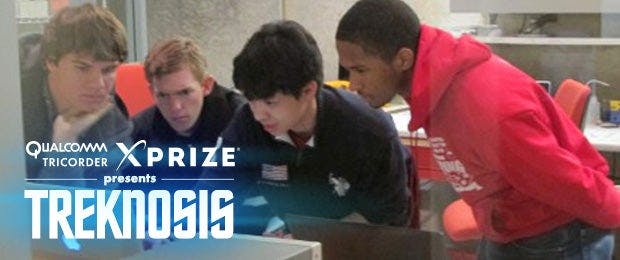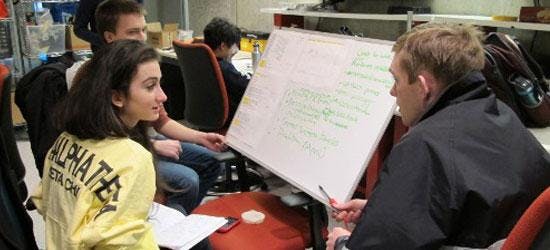Published Jun 16, 2014
TREKNOSIS: Forged in Battle: Team Aezon's Origin
TREKNOSIS: Forged in Battle: Team Aezon's Origin

You may have heard about Team Aezon already. They're the youngest team competing for the $10M Qualcomm Tricorder XPRIZE – an incentivized competition challenging teams around the world to create a real-life, Star Trek-inspired medical Tricorder. They're all undergrads at Johns Hopkins University. Whatever your impression of most undergrads is, it probably doesn't include a serious, innovative attempt to build a working medical Tricorder. So, how'd this team come together? And where'd their leader, Tatiana Rypinski, get her start?
Gladiatorial combat, basically.
Before her freshman year of high school, Rypinski found herself on a California university campus on vacation with her family. At some point, they wandered into a gym that boomed and rang with the noise of screams and cheering. As a field hockey and lacrosse player, Rypinski was no stranger to the sounds of competition, but what she saw in the arena was like nothing she'd encountered before: robots whirling and pounding on each other with built-in weaponry, controlled by teams of high school kids. And just like that, the seed was planted. "I really wanted to be a part of it, to learn what they were doing," she recalls.
Rypinski soon started her own high school team in Rockville, Maryland. For three years, she led them from competition to competition, picking up more than just the occasional trophy. Being a team leader taught her invaluable lessons not only in systems integration and materials, but also about the design process, how to work under intense deadlines and what makes a good team tick. "As leader," she said, "one of the most important things is to be a good listener, so you can hear the subtleties of what's going on with your team – or particular people – and work to resolve any conflicts that might come up."
At the same time, she was developing an interest in something entirely different. Rypinski's grandfather had a friend who'd been rendered quadriplegic, and his struggle to live a normal life, assisted by various devices and prosthetics, moved her: "I was interested in how they worked, and in their limitations from an engineering standpoint." Were there advances to be made? She'd read about cutting-edge prosthetics that could be connected to residual nerve endings, allowing them to be controlled by their users like replacement limbs, though they probably wouldn't be market-ready for a long time. Other promising-sounding medical technologies seemed just over the horizon, too, like nanotechnology designed for targeted drug delivery.
The time soon came to pick a college major. Rypinski's interest in advancing prosthetic technology jumped to the next level: biomedical engineering. In the Johns Hopkins program, one of the best in the country, she'd learn to design and create devices designed to enhance human health and our understanding of it. "I like to build things," she says, "and I'm really interested in both the human body and devices that can interface with it."
Then came that fateful morning when Rypinski read about the $10M Qualcomm Tricorder XPRIZE. "It seemed like a cool project," Rypinski said, "and a fun challenge." She composed an email that would go out to everyone across all the engineering departments at Hopkins, plus the science majors. "I had no idea what the response would be," she recalls, "but I had nothing to lose." She hit SEND.

And the responses came. Like the gear-up scene in a quality heist movie, engineering and science students answered the call from all over, getting out from behind computers and lab benches to assemble Team Aezon. Drawing on leadership experience gained from her time at the head of her robotics team, Rypinski decided to be as hands-on as possible. "I don't like just telling people what to do," she explains. "Team structure is constantly evolving; everyone gets to have a hand in everything, because we're building an entire system. If you work in app development, for example, you get to learn a lot about the diagnostics, because your app has to interact with them."
Rypinski thinks Team Aezon's greatest strength is in their youth and enthusiasm. On the one hand, everyone on the team is ready and willing to come together to work through the tough problems, of which there are no shortages. On the other, they're not old and cynical yet. Not being industry veterans, they're not hampered by the limitations in thinking that might be baked into the mindset of a bunch of veterans. "I think when you're trying to do something that hasn't been done before," she notes, "the reaction is kind of a negative one." For instance, one part of Aezon's solution is a monitoring device designed to gather five different vital signs at once, to be worn around the neck. "That hasn't been done before," Rypinski says, but maybe that's just because everyone else thinks, "there must be some reason it hasn't been done before."

Right now, Team Aezon's focus is on refining their approach to be minimally intrusive. "Part of the XPRIZE goal is to drive consumer adoption of this technology," Rypinski notes, "and with that aim, we're trying to develop our solutions to be relatively noninvasive for the consumer, which will help from a regulatory standpoint, in terms of getting FDA approval, but also consumers being comfortable with it." She's had a lot of time to think about this, which is even more surprising considering that she has to balance classes in the morning, Aezon work in the afternoon and on weekends, and homework in the evening. But she's making it happen – probably old hat to anyone who can run a robotics team of high school kids for years on end. “Innovation,” she concludes, "is sometimes about looking at an old way to do something, but applying it in a new way."
Jon Sung is a contributing writer for XPRIZE and copywriting gun-for-hire to startups and ventures all over the San Francisco Bay area. When not wrangling words for business or pleasure, he serves as the first officer of the USS Loma Prieta, the hardest-partying Star Trek fan club in San Francisco.
XPRIZE is an innovation engine. We design and operate prize competitions to address global crises and market failures, and incentivize teams around the world to solve them. Currently, we are operating numerous prizes including the $30M Google Lunar XPRIZE, challenging privately funded teams to successfully land a robot on the Moon’s surface, and the $10M Qualcomm Tricorder XPRIZE, challenging teams around the world to create a portable, wireless, Star Trek-inspired medical device that allows you to monitor your health and medical conditions anywhere, anytime. The result? Radical innovation that will help us all live long and prosper.
Sign up today to join our mission, be a part of our campaign and win collectibles at: tricorderfederation.org.





